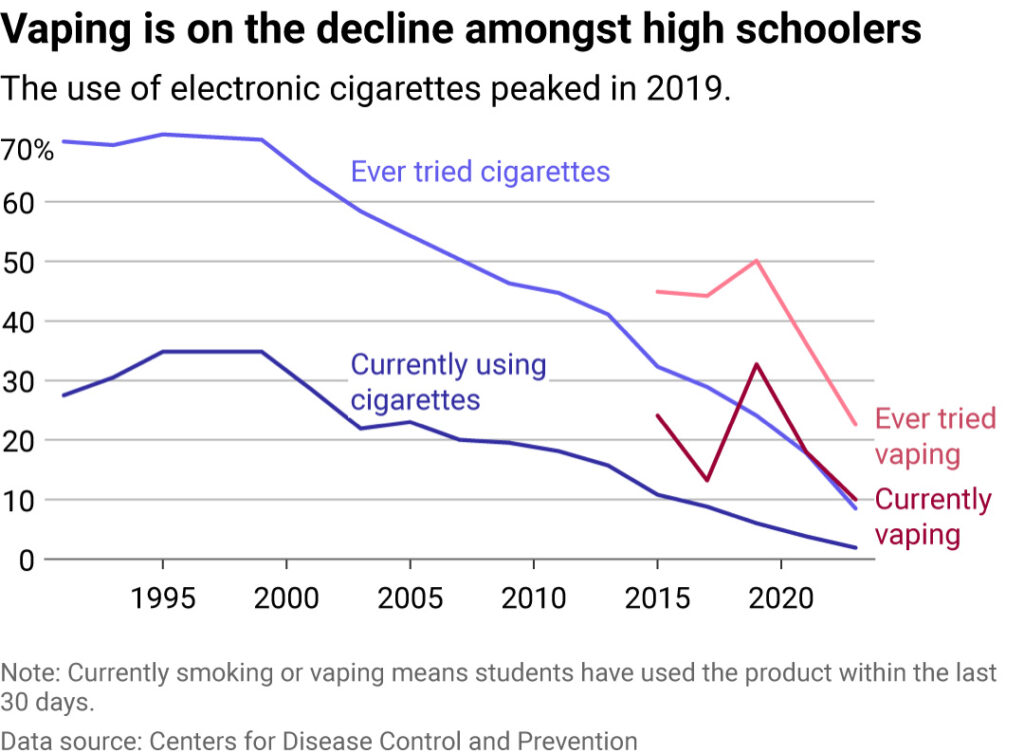Vaping is Finally on a Downward Trend in Schools
Counseling Schools Search
When you click on a sponsoring school or program advertised on our site, or fill out a form to request information from a sponsoring school, we may earn a commission. View our advertising disclosure for more details.
The allure of e-cigarette usage for high schoolers is waning, according to newly published survey data by the Centers for Disease Control and Prevention.
Counseling Schools used data from the CDC survey, academic studies, and news articles to track trends in vaping and tobacco use among high schoolers in America.
Electronic cigarettes, also known as vapes, entered the U.S. marketplace around 2007. The use of e-cigarettes surged by 900 percent among middle and high school students between 2011 and 2015, according to a report from the office of former U.S. Surgeon General Vivek H. Murthy.
By 2018, the first U.S. vaping fatality, caused by an exploding e-cigarette pen, made worldwide news—the same year TikTok became the most downloaded app in the U.S.
Still, the vaping rates of young people persisted. A study published in the official journal of the American Academy of Pediatrics found that another peak in vaping use among minors in 2019 was associated with highly increased sales of Juul. This once-popular e-cigarette manufacturer introduced higher-dosed nicotine products with flavors like mango, mint, and creme brulee that appealed to young people. CDC data collected in 2023 found that of the students who vape, just under 90 percent used flavored products.
Minnesota was the first state to make it to a trial with Juul in March 2023 after filing a lawsuit against the company in 2019. Attorney General Keith Ellison said Juul “baited, deceived, and addicted a whole new generation of kids after Minnesotans slashed youth smoking rates down to the lowest level in a generation.”
While Juul attorney David Bernick said the company did not intentionally drive youth demand, their targeting of adults with a “less dangerous product” could have spurred increased youth vaping.
Dr. Sarper Taskiran, a senior child and adolescent psychiatrist in the Psychopharmacology Center at the Child Mind Institute, said there is a misconception that vaping isn’t harmful to users’ health. “They really think that they are mostly flavors and that they are inhaling a pleasant gas,” Taskiran said in an interview for the institute’s website.
The aerosol vapor from e-cigarettes contains cancer-causing chemicals, the institute said. The packaging “says 5 percent nicotine, which sounds like nothing, so teens think 95 percent is water weight or vapor,” Taskiran said.
While the amount of nicotine in various e-cigarette products differs, a Healthline analysis shows that 15 puffs of an e-cigarette match the nicotine content of an entire cigar. Nicotine use in adolescents can harm brain development that controls attention, learning, mood, and impulse control. It can also increase the risks of future addictions to other drugs.
Despite all of the harms caused by vaping and the influence of e-cigarette manufacturers on U.S. minors, at its peak, the vaping rate of U.S. high schoolers doesn’t come close to the historically high rates of cigarette smoking among the same age cohort some 20 years before. But, according to the CDC data, its decline has been much more rapid than that of cigarette smokers.

Online Culture Can Reinforce the Multipronged Harms of Vaping
Efforts to curb e-cigarette smoking among young people have struggled to keep pace with industry trends. In 2019, Juul ceased advertising in the U.S. and discontinued most of its flavors as part of the FDA’s ban on “teen-preferred flavors” from reusable e-cigarettes. The flavor ban didn’t apply to disposable vapes—the kind that more than half of teens use, according to the FDA’s 2023 National Youth Tobacco Survey. Juul has settled legal cases with 48 states and U.S. territories.
Meanwhile, competitors have flooded the market, many of which are imported and not FDA-approved. Between 2020 and 2022 alone, 46 percent of new reusable and disposable vape brands sold in the U.S., according to the CDC’s Morbidity and Mortality Weekly Report.
As of late 2023, around 2,000 vaping and e-cigarette brands are on the market, 90 percent of which are from Chinese factories. The FDA has yet to approve any disposable vape brands and is struggling to regulate the market, particularly as diplomatic relations with China remain tense. By contrast, Australia has an outright ban on all disposable vape imports starting January 2024.
The FDA can ban imports of illegal products and warn retailers who are selling unauthorized products, but that doesn’t stop minors from getting vapes online.
The internet, more specifically TikTok, is an echo chamber for vaping use among young people. A comprehensive analysis by Australian researchers found that a majority of TikToks featuring vaping (63 percent) depicted its use positively. In 2020, a third of TikTok’s users were 14 or younger.
Yet, teen vaping rates appeared to fall by about 40 percent in 2020, as many were going to school remotely, according to a 2021 CDC survey, which was conducted online for the first time.
Teen vaping rates may continue to decrease—with or without Juul’s recent attempt to sell vapes while “blocking” underage users using Bluetooth technology. TikTokers went viral in late November 2023, vowing to quit vaping in response to reports of child labor abuses in the Democratic Republic of Congo’s mining of cobalt, used in disposable vapes. Disposable vapes also create huge amounts of e-waste: An estimated 150 million vapes containing cobalt and other materials like iron and copper end up in landfills yearly.
Vaping Rates in Middle School: A Slightly Different Trajectory
CDC data also shows that vaping among middle schoolers has climbed from 3.3 percent in 2022 to 4.6 percent in 2023. Bebi Davis, the vice principal of Kawānanakoa Middle School in Hawaii, told EducationWeek that younger students may not have been as exposed to anti-vaping messages during remote schooling.
Now that middle schoolers have returned to in-person learning, school staff may struggle to notice changing tobacco technologies. Davis said that vapes that once were mistaken for pens and new oral tobacco pouches can look like candy.
Kurt Ribisl, a University of North Carolina researcher, spoke to NBC News about the middle school data, saying it may be too soon to be concerned. While smoking rates of middle and high schoolers usually rise and fall together, he said that the survey’s finding may be a short-term blip.

